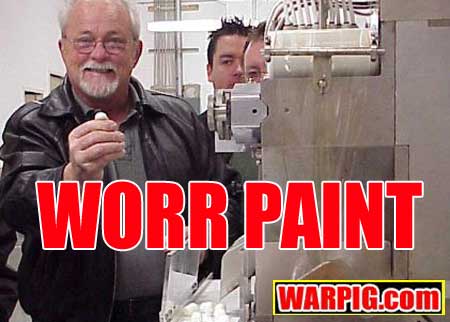  |
|
|
|
|
|
|
  |
|
|
|
|
|
|

Photo Gallery of Worr Paint being made at IPMc PigTV
video interview with Bud Orr and a tour of the IPMc factory
What do you think? Add your comments in WARPIG's REC TALK Forum
|

IPMc produces Worr Paint by Bill Mills On July first, 2002, International Paintball Manufacturing in Saint Petersburg, Florida announced its grand opening. On February 13th, the same year, they invited WARPIG.com to take a sneak preview of the facility and see the very first paintballs to roll off of their production lines. While IPMc is now producing paintballs for the world-wide market, they have teamed up with industry leader Bud Orr of Worr Game Products to produce the Worr Paint paintball as their exclusive brand in the United States.
Bud introduced us to Jeff Danta. Jeff is not only the plant manager for International Paintball Manufacturing, but also the designer of much of the factory's layout. He has a long career in the softgel industry, and has overseen the production of some major brand paintballs in the past. Jeff started our tour by showing the factory map. More prominent on the map than the walls and machines were color coded paths that showed the paths that employees and equipment take through the entire manufacturing process, and the clean-up afterward. Jeff explained that the art of making a paintball that is consistent is tied tightly to keeping everything in the manufacturing process consistent. That includes how long materials sit between stages, and one way to help control that is to be very specific about the routes they take between machines. Danta showed us the receiving warehouse. This is where the raw materials are delivered. The gelatin arrives in a granulated form, in large bags on palettes. Jeff said they had already drawn up plans for a bulk receiving facility where full truckloads of gelatin could be unloaded directly into storage bins, but that would wait until a cost analysis showed them which delivery method was most effective. From the warehouse, the gelatin goes to giant cooking vats. Here it is heated and slowly mixed until it turns from powder to a warm, thick liquid. Careful control of mixing speeds, and pressure inside the tank is very important to make sure that air bubbles do not froth up the gelatin, as they could cause problems down the line. The gelatin is then piped into large stainless steel flasks.
The pigments and fill of the paint were similarly mixed in large rolling flasks, though for them, temperature and pressure were not nearly as critical. Then came the big room. The flasks of gelatin and fill were wheeled into the encapsulation room. While we were there, the first of these machines was operational, and two were being installed. Two more would fill up the room. Jeff also showed us that one of the walls in the room was temporary, and would eventually be taken down doubling the size of the room for another row of five machines in a mirror image layout. For the first test runs, the paint fill was transferred to the encapsulation machine one bucket full at a time. This would soon be replaced by a pump system. Behind the encapsulation machine two flasks of gelatin were hoisted into the air, and hoses linked them in. The machine drew in the gelatin through the hoses and it was spread evenly on a large, chilled, slowly rotating steel drum. The cold temperature chilled it down into a clear rubbery sheet, and a thin layer of oil on the drum prevented it from sticking (this is what sometimes gives paintballs their slightly oily texture). The gelatin came a way from the drum in a wide ribbon, and traveled over a set of rollers up and around to the front of the machine. On the other side of the machine, another drum and rollers were producing an identical ribbon out of gelatin from the other flask. These two ribbons would become the two halves of the paintball shell. At the front of the machine, the two ribbons came together, sliding down the sides of a wedge. At the point of the wedge, they were squished together by a pair of rolling dies. These two dies have oval shaped pockets in them, and sharp cutting edges around the pockets. As two pockets come together they create and cut out what is basically a sandwich of two disks of gelatin. At the moment it is forming, the wedge squirts just enough paint to blow this sandwich up like a balloon, a moment before the top edge is sealed together.
According to Danta, having a drying room next to each machine helps streamline product movement, and makes it easier to trouble shoot if any problems arise in the paint. In each drying room, air flows from ventilators on one side to an exhaust on the other. The air in the drying rooms, and the whole facility is very carefully treated. It is first dehumidified (all the moisture is removed) and then specially cleaned and chemically enhanced moisture is added back into the air. This allows the exact humidity and temperature of the air to be precisely controlled. Out of the drying room, the paint is bagged, boxed, and send on it's way. Through the spring of 2002 IPMc manufactured, tested, adjusted, and manufactured more paint with constant feedback from Worr Game Products, selected paintball fields, and WGP sponsored teams like Missouri Magic. IPMc refined both the quality of the paintballs they were producing, and their colors and fills. This process led to the actual grand opening announcement on July first, and the availability of Worr Paint from Worr Game Products. For more about IPMc and Worr Paint,
CLICK
HERE for a Photo Gallery of Worr Paint being made at IPMc, or CLICK
HERE to watch a PigTV video interview with Bud Orr and a tour of the
IPMc factory.
|
| Copyright © 1992-2019
Corinthian Media Services. WARPIG's webmasters can be reached through our feedback form. All articles and images are copyrighted and may not be redistributed without the written permission of their original creators and Corinthian Media Services. The WARPIG paintball page is a collection of information and pointers to sources from around the internet and other locations. As such, Corinthian Media Services makes no claims to the trustworthiness or reliability of said information. The information contained in, and referenced by WARPIG, should not be used as a substitute for safety information from trained professionals in the paintball industry. |